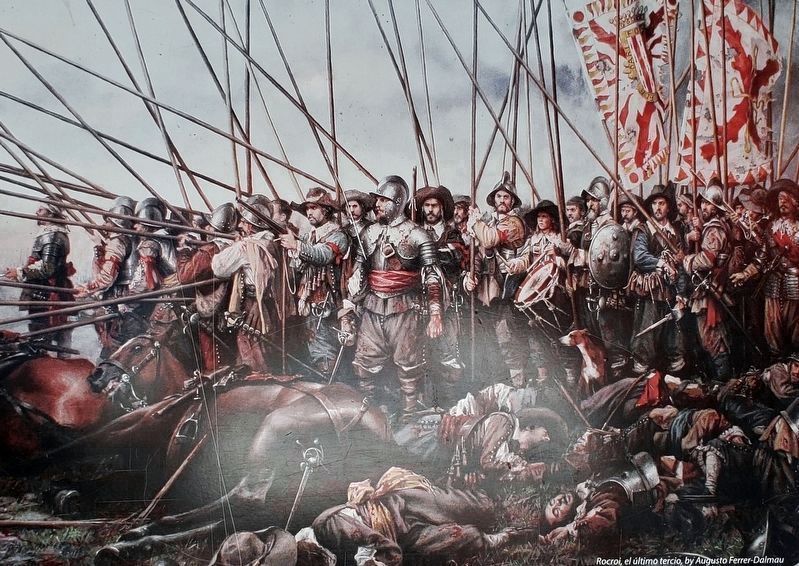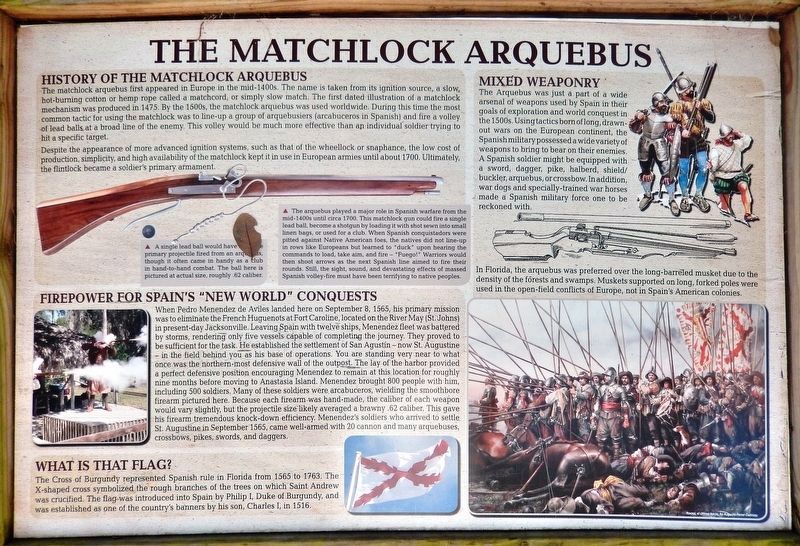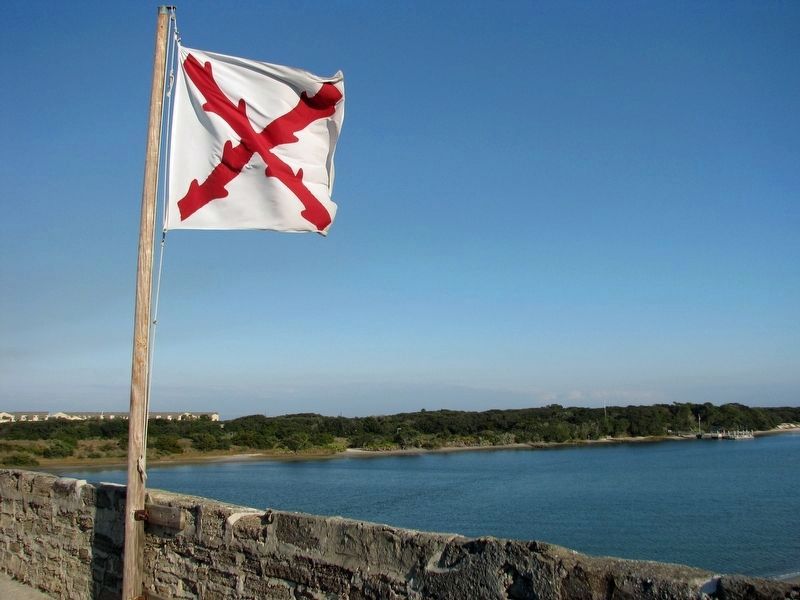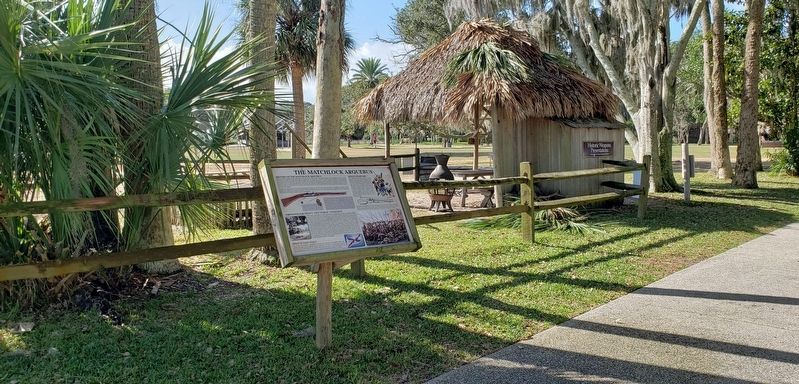St. Augustine in St. Johns County, Florida — The American South (South Atlantic)
The Matchlock Arquebus
History of the Matchlock Arquebus
The matchlock arquebus first appeared in Europe in the mid-1400s. The name is taken from its ignition source, a slow, hot-burning cotton or hemp rope called a matchcord, or simply slow match. The first dated illustration of a matchlock mechanism was produced in 1475. By the 1500s, the matchlock arquebus was used worldwide. During this time the most common tactic for using the matchlock was to line-up a group of arquebusiers (arcabuceros in Spanish) and fire a volley of lead balls at a broad line of the enemy. This volley would be much more effective than an individual soldier trying to hit a specific target.
Despite the appearance of more advanced ignition systems, such as that of the wheellock or snaphance, the low cost of production, simplicity, and high availability of the matchlock kept it in use in European armies until about 1700. Ultimately, the flintlock became a soldier's primary armament.
Firepower for Spain’s “New World” Conquests
When Pedro Menendez de Aviles landed here on September 8, 1565, his primary mission was to eliminate the French Huguenots at Fort Caroline, located on the River May (St. Johns) in present-day Jacksonville. Leaving Spain with twelve ships, Menendez fleet was battered by storms, rendering only five vessels capable of completing the journey. They proved to be sufficient for the task. He established the settlement of San Agustín — now St. Augustine — in the field behind you as his base of operations. You are standing very near to what once was the northern-most defensive wall of the outpost. The lay of the harbor provided a perfect defensive position encouraging Menendez to remain at this location for roughly nine months before moving to Anastasia Island. Menendez brought 800 people with him, including 500 soldiers. Many of these soldiers were arcabuceros, wielding the smoothbore firearm pictured here. Because each firearm was hand-made, the caliber of each weapon would vary slightly, but the projectile size likely averaged a brawny .62 caliber. This gave his firearm tremendous knock-down efficiency! Menendez's soldiers who arrived to settle St. Augustine in September 1565, came well-armed with 20 cannon and many arquebuses, crossbows, pikes, swords, and daggers.
What is that Flag?
The Cross of Burgundy represented Spanish rule in Florida from 1565 to 1763. The X-shaped cross symbolized the rough branches of the trees on which Saint Andrew was crucified. The flag was introduced into Spain by Philip I, Duke of Burgundy, and was established as one of the country’s banners by his son, Charles I, in 1516.
Mixed Weaponry
The Arquebus

2. Marker detail: Matchlock Arquebus
A single lead ball would have been the primary projectile fired from an arquebus, though it often came in handy as a club in hand-to-hand combat. The ball here is pictured at actual size, roughly .62 caliber.
The arquebus played a major role in Spanish warfare from the mid-1400s until circa 1700. This matchlock gun could fire a single lead ball, become a shotgun by loading it with shot sewn into small linen bags, or used for a club. When Spanish conquistadors were pitted against Native American foes, the natives did not line-up in rows like Europeans but learned to "duck" upon hearing the commands to load, take aim, and fire — "Fuego!" Warriors would then shoot arrows as the next Spanish line aimed to fire their rounds. Still, the sight, sound, and devastating effects of massed Spanish volley-fire must have been terrifying to native peoples.
In Florida, the arquebus was preferred over the long-barreled musket due to the density of the forests and swamps. Muskets supported on long, forked poles were used in the open-field conflicts of Europe, not in Spain's American colonies.
Topics. This historical marker is listed in these topic lists: Colonial Era • Exploration • Settlements & Settlers. A significant historical year for this entry is 1475.
Location. 29° 54.421′ N, 81° 18.837′ W. Marker is in St. Augustine, Florida, in St. Johns County. Marker can be reached from Williams Street east of Magnolia Avenue. Marker is located along the interpretive trail in Ponce de León's Fountain of Youth Archaeological Park. Touch for map. Marker is at or near this postal address: 11 Magnolia Avenue, Saint Augustine FL 32084, United States of America. Touch for directions.
Other nearby markers. At least 8 other markers are within walking distance of this marker. Don Juan Ponce De Leon (within shouting distance of this marker); Continuing Archaeology
(within shouting distance of this marker); Juan Ponce De León (within shouting distance of this marker); a different marker also named Juan Ponce De León (within shouting distance of this marker); The Fountain of Youth (within shouting distance of this marker); Juan Ponce De Leon (within shouting distance of this marker); a different marker also named Juan Ponce De León (within shouting distance of this marker); a different marker also named Juan Ponce De León (within shouting distance of this marker). Touch for a list and map of all markers in St. Augustine.
Related markers. Click here for a list of markers that are related to this marker. Ponce de León's Fountain of Youth Archaeological Park
Also see . . .
1. Arquebus.
Prior to the appearance of the serpentine lever by around 1411, handguns were fired from the chest, tucked under one arm, while the other arm maneuvered a hot pricker to the touch hole to ignite the gunpowder. The matchlock, which appeared roughly around 1475, changed this by adding a firing mechanism consisting of two parts, the match,(Submitted on December 28, 2021, by Cosmos Mariner of Cape Canaveral, Florida.)and the lock. The lock mechanism held within a clamp a two to three feet long length of smoldering rope soaked in saltpeter, which was the match. Connected to the lock lever was a trigger, which lowered the match into a priming pan when squeezed, igniting the priming powder, causing a flash to travel through the touch hole, also igniting the gunpowder within the barrel, and propelling the bullet out the muzzle. 4. Marker detail: Rocroi, el último tercioRocroi, The Last Tercio (2011) by the contemporary artist Augusto Ferrer-Dalmau. Depicts the defeat of the Spanish army in the Battle of Rocroi against the French. The Battle of Rocroi occurred near the end of the Thirty Years' War and is an important battle in world history. The French defeat of the Spanish army marks the end to a century and a half of battles won by the Spanish army.
4. Marker detail: Rocroi, el último tercioRocroi, The Last Tercio (2011) by the contemporary artist Augusto Ferrer-Dalmau. Depicts the defeat of the Spanish army in the Battle of Rocroi against the French. The Battle of Rocroi occurred near the end of the Thirty Years' War and is an important battle in world history. The French defeat of the Spanish army marks the end to a century and a half of battles won by the Spanish army.
2. Matchlock Arquebus Demonstration. (professional quality youtube video) (Submitted on December 28, 2021, by Cosmos Mariner of Cape Canaveral, Florida.)
Credits. This page was last revised on December 29, 2021. It was originally submitted on December 27, 2021, by Cosmos Mariner of Cape Canaveral, Florida. This page has been viewed 851 times since then and 131 times this year. Photos: 1, 2, 3, 4, 5. submitted on December 28, 2021, by Cosmos Mariner of Cape Canaveral, Florida.


